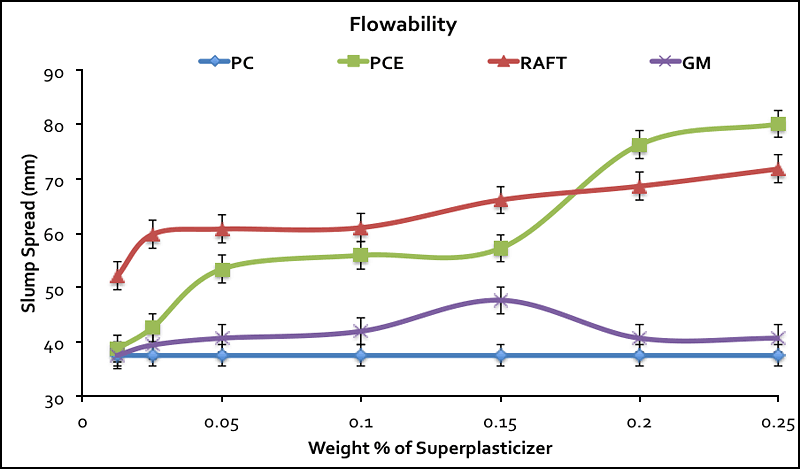Cement
Cement is the most widely used engineered material on Earth, with over 7 trillion pounds produced globally each year. However, the manufacture of cement contributes more than 5% of total CO2 production, and efforts to reduce this require incorporation of alternative supplementary cementitious materials (ASCMs), such as limestone, clays, or zeolites. The challenge in using ASCMs is they significantly reduce the workability of the cement paste before it has set, making them much harder to use than ordinary Portland cement.
Following the addition of water, cement pastes behave as Bingham fluids, characterized by elastic behaviour up to a yield stress after which the material flows with a characteristic viscosity (toothpaste is a classic example). To improve the workability, a class of polymeric additives known as plasticizers or superplasticizers are used to reduce the yield stress. Lignosulfonates are a widely used class of plasticizer used to improve the workability of cement paste, which are derived from sulfite pulping. However, the leading admixtures for improving workability are poly(carboxylate ether) (PCE) comb copolymers. Our early results show that polymer-grafted lignin nanoparticles could offer performance that rivals PCE.
A standard measure of workability is slump spread measurements, which are simple but actually have a firm theoretical basis in connecting the results to the yield stress of the cement paste. In these tests, wider spreading of the cement paste after it is released from the form is associated with lower yield stresses, scaling as 1/R5 where R is the value for the slump spread.

Images of slump spread experiments using a water/cement ratio of 0.42.
In our first paper on applications in cement, kraft lignin grafted with polyacrylamide was prepared using controlled radical polymerization (RAFT) and compared with material having the same composition but prepared via free radical polymerization using lignin functionalized with glycidyl methacrylate (GM). Their effects on the workability of cement were compared against a commercial PCE superplasticizer as a function of concentration. The RAFT lignin product performed much better than the FRP product and was competitive with the commercial PCE at high concentrations and was still effective at 10x lower concentration. These results suggest that the dispersant characteristics of lignin can be significantly augmented through controlled polymer grafting.

Slump spread values for Portland cement paste as a function of superplasticizer concentration. Neat Portland cement (OPC) was compared with formulations containing kraft lignin grafted with polyacrylamide using controlled radical polymerization (RAFT) and free radical polymerization (FRP) as well as a commercial PCE. Higher slump spread values are associated with improved workability, and the RAFT product showed excellent performance at high concentration and sustained effects even at 10x lower concentration.
Improving the properties and reducing the environmental impact of cement are critical issues. It is also an excellent research area for training both science and engineering students in molecular engineering.
References:
A fifty cent rheometer for yield stress measurement. N. Pashias, D. V. Boger, J. Summers and D. J. Glenister, J Rheol, 1996; 40: 1179–1189.
Innovation in use and research on cementitious material. K. L. Scrivener and R. J. Kirkpatrick. Cement and Concrete Research. 2008; 38: 128–136.
Molecular architecture requirements for polymer-grafted lignin superplasticizers. C. Gupta, M. J. Sverdlove, N. R. Washburn. Soft Matter. 2015; 11: 2691–2699.
|